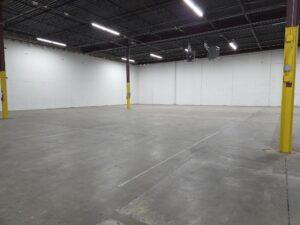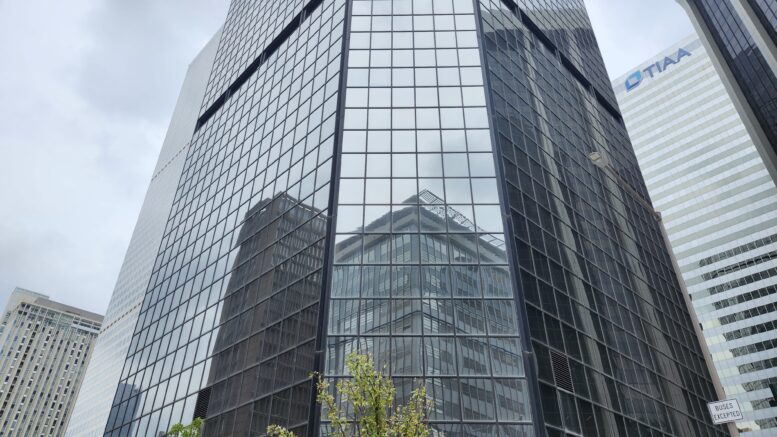Owners of large commercial buildings have reached a crucial crossroads slightly more than four years before they must meet new emissions-reduction standards: Begin the costly makeovers needed for compliance or hope that a lawsuit to overturn the rules succeeds.
The compliance path involves significant spending — millions of dollars each for larger offices, warehouses and apartment buildings — at a time when urban office vacancy is hitting new records and defaults are becoming common in the sector. Colorado legislators passed a law in May that loosens some requirements and reduces fines, but it nonetheless requires investment in building upgrades even as leaders of several building-management groups say that finding financing for doing such work is nearly impossible.
Meanwhile, a lawsuit from several industry associations seeks to overturn the state’s building performance standards program, arguing that it violates federal law establishing nationwide energy-conservation standards for commercial equipment in buildings. While Colorado Energy Office leaders have been adamant that the state regulations do not require any building owner to replace working equipment with electrification, plaintiffs argue that they can’t reach the new standards without overhauling HVAC systems.
A hard time for building owners
Commercial buildings of at least 50,000 square feet must reduce sector-wide emissions 20% by 2030 through some combination of energy efficiencies, upgrades and potential conversion of gas-powered heating and cooling to electric alternatives like heat pumps. The mandate, passed in 2023, marks one of many efforts by state leaders to cut greenhouse-gas emissions from sectors including oil and gas, industrial facilities, transportation and lawn and garden equipment.
While few building owners disagree with the premise that reducing emissions will not only help the environment but will save on utility bills in the long run, most say there couldn’t be a worse time to require them to spend significant amounts of money on it. Pandemic-sped changes have hollowed out many formerly bustling buildings in places like downtown Denver, creating average vacancy rates of 36% that in turn have led to massive loan defaults and to owners handing over money-bleeding skyscrapers to lenders.
Even owners who want to make energy upgrades can’t find anyone willing to lend to them because they’ve already spent so much capital trying to keep their properties afloat, said Kathie Barstnar, executive director of commercial real estate association NAIOP Colorado. NAIOP — along with the Colorado Apartment Association, Apartment Association of Metro Denver and Colorado Hotel and Lodging Association — filed the lawsuit to overturn the law.
“We do not oppose energy efficiency. We’re not anti-environment. We’re anti-bankruptcy,” Barstnar said in an interview. “The targets set up people for failure. It’s not that people don’t want to comply. There’s no money to do so.”

NAIOP Colorado Executive Director Kathie Barstnar speaks at a rally at the Capitol in March 2024 for construction-defects reform.
Why the state wants building emission reductions
State leaders say they understand current industry hardships, and they worked with groups like Denver Metro BOMA to ease the rules slightly this past session. Required 7% emissions cuts scheduled for 2026 became recommendations, fines came down, buildings owners were allowed to use 2019 (when buildings were less vacant) rather than 2021 as their benchmark for emissions and they got seats on two boards overseeing the process.
But it remains important, especially as the Northern Front Range is classified as a severe violator of U.S. Environmental Protection Agency ozone standards, to reduce emissions, and the buildings sector is essential to doing that, state leaders say. House Bill 1269 also set up an enterprise — one, admittedly, that building owners will have to pay $400 into annually — that will offer both technical and financial assistance in making upgrades, but the work is too important to delay, they argue.
“Buildings are among the leading contributors to greenhouse gas pollution in Colorado, which is why building energy efficiency and electrification are essential to achieve our climate goals while saving building owners and tenants money on energy costs and improving indoor air quality,” said Ari Rosenblum, Colorado Energy Office associate director of communications and engagement. “We look forward to working with Colorado building owners and operators to ensure a cleaner and safer built environment.”
Building owners, then, must decide whether to begin the work of compliance or to put all their eggs in the basket of possible lawsuit success. And they must decide now, particularly as most building owners do capital plans that run five years out to ensure they have enough money to make major changes, Denver Metro BOMA executive vice president Stephen Shepard said.
What building owners must do
The first move many of them will make is to undertake an American Society of Heating, Refrigeration and Air Conditioning Society Engineers Level 2 Energy Audit to determine how much energy the building consumes and what can be done to cut it back. Auditors will look at building conditions, occupancy patterns, lifetime energy usage and the amount of power that is being used and can propose short-term and long-term plans, explained Voytek Gretka, a building energy consultant.
Most owners will find that they don’t need to rip out perfectly good gas-powered heating systems and electrify, as there are a lot of less costly moves that can be made, Gretka said. Replacing light bulbs and lighting tubes can lead to surprisingly significant energy savings. Changes to mechanical control systems that limit heating and lighting during low-use times can make a big difference. New equipment may be needed, but not always, he said.

The interior of a warehouse owned by RBF Family Limited Partnership.
The state offers two paths to compliance, allowing for reduction of a hard number of greenhouse-gas emissions or reduction of a certain percentage of emissions — essentially allowing buildings to decide whether to clean up or decarbonize. Audits can sometimes signal that buildings are using far more energy than owners suspect, giving them multiple pathways to meet the targets, Gretka said.
“If I was a building owner, I would try to go after those low-cost things first, and you may find huge savings there,” he said. “But don’t wait. Because the compliance timeline has been moved forward (from 2026 to 2030), that’s to your benefit — but not your benefit to procrastinate.”
Will electrification be necessary?
The lawsuit, however, argues that the law does, in fact, put in place standards that run counter to federal regulations and will require the gutting of working equipment to achieve compliance. A U.S. District Court judge threw out the lawsuit originally because it did not allege this crucial point with any proof. Plaintiffs then refiled in June with multiple declarations from building owners who have undertaken assessments and received reports that they must make major upgrades.
One of those was Steve Fletcher, the managing partner at RBF Family Limited Partnership, which owns several industrial properties in the Denver area, including warehouses that his father built in the 1970s. Following passage of building-performance standards by both the state and Denver, Fletcher undertook audits to see how to hit Energize Denver minimum energy use intensity scores (as the state law lets owners comply just with local standards if the local laws are as strict as the state’s). The feedback he got was “very daunting,” he said.
The audit first suggested significant energy-efficiency measures like tenant-specific heating and cooling scheduling, LED light replacement and water-fixture upgrades, as well as installation of an onsite solar rooftop array, according to Fletcher’s lawsuit declaration. But it added that the efficiency and solar measures by themselves wouldn’t bring the buildings into compliance in a timely way and suggested replacement of mechanical cooling and gas-heating equipment, some of which is only a few years old, with HVAC electrification.
2030 looms close
Those upgrades could cost at least $175,000 with a 14-year payback at a time when some RBF properties are half-vacant and another is fully occupied only because the company recently reduced rent there, Fletcher said. He’s already begun to go after quick fixes — adding LED lighting in all facilities, boosting insulation and resealing the dock and drive-in doors — but he is watching the lawsuit closely as he determines where he can find additional needed funds.

The exterior of a warehouse owned by RBF Family Limited Partnership
“I know some owners are taking the ostrich approach of ‘Hey, we’re not doing anything because we hope (the lawsuit) turns out well.’ I know some owners are taking the extreme proactive approach. What we’ve tried to do is take care of the low-hanging fruit we could afford,” Fletcher said in an interview. “As far as the big stuff, we’ll just have to wait and see. If the lawsuit isn’t successful, I don’t know what we’ll do.”
State officials have advised building owners to continue working to achieve the 2030 building performance targets, which are not changing as the lawsuit works its way through the system. The new enterprise is taking applications for its nine-member board and could be offering technical and financial resources as soon as mid-2026, all in an effort to help building owners comply rather than fine them.
“The new Building Decarbonization Measures legislation will make it easier for buildings to comply with the state’s building energy performance standards, removing interim targets to allow more time to comply and creating additional financial resources to invest in building decarbonization efforts across the state,” Rosenblum added in a statement.
Aspirations versus reality?
Shepard, whose organization is not involved with the lawsuit and worked to pass the compromise bill this session, advises members that if they do audits and find it will be extremely difficult to reach compliance, they should at least reach out to state officials. The new law allows for some buildings to seek individualized targets if they can prove special circumstances, but requests for those will likely be viewed more favorably in the near future than if they are made in late 2029, he said.
But, similar to the groups taking the legal-action route, Shepard believes it will be very difficult for the state to achieve 20% emission reductions from benchmark levels by 2030 at a time when building owners have limited capital. And he wonders what will happen at that point — namely, whether the state will work once again to reform its rules or whether it will push financially hamstrung business owners to make changes that may force them to give up ownership of their properties.
“There’s going to come a point where the aspirations and the reality are going to be so far diverged that it’s too big a gap to close as they envision it to close,” Shepard said. “Is it really worth wrecking an economy over this? Stephen Shepard says ‘no.’”
